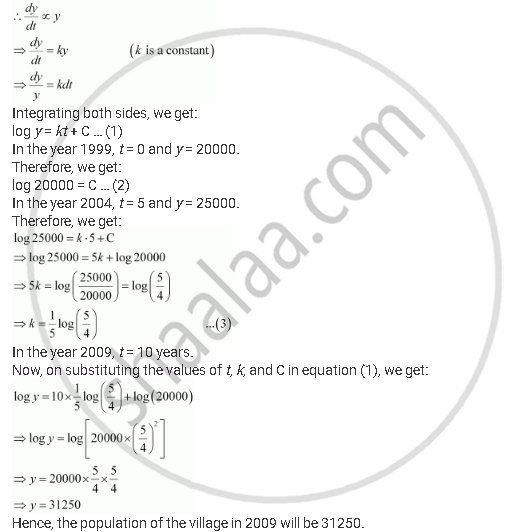Advertisements
Advertisements
Question
The population of a village increases continuously at the rate proportional to the number of its inhabitants present at any time. If the population of the village was 20000 in 1999 and 25000 in the year 2004, what will be the population of the village in 2009?
Solution
Let the population at any instant (t) be y.
It is given that the rate of increase of population is proportional to the number of inhabitants at any instant.

APPEARS IN
RELATED QUESTIONS
For the differential equation, find the general solution:
`dy/dx + 3y = e^(-2x)`
For the differential equation, find the general solution:
`dy/dx + (sec x) y = tan x (0 <= x < pi/2)`
For the differential equation, find the general solution:
`cos^2 x dy/dx + y = tan x(0 <= x < pi/2)`
For the differential equation, find the general solution:
`x dy/dx + 2y= x^2 log x`
For the differential equation, find the general solution:
`x dy/dx + y - x + xy cot x = 0(x != 0)`
For the differential equation, find the general solution:
`(x + 3y^2) dy/dx = y(y > 0)`
For the differential equation given, find a particular solution satisfying the given condition:
`(1 + x^2)dy/dx + 2xy = 1/(1 + x^2); y = 0` when x = 1
Find the equation of the curve passing through the origin given that the slope of the tangent to the curve at any point (x, y) is equal to the sum of the coordinates of the point.
Find the equation of a curve passing through the point (0, 2) given that the sum of the coordinates of any point on the curve exceeds the magnitude of the slope of the tangent to the curve at that point by 5.
The Integrating Factor of the differential equation `dy/dx - y = 2x^2` is ______.
Solve the differential equation `x dy/dx + y = x cos x + sin x`, given that y = 1 when `x = pi/2`
x dy = (2y + 2x4 + x2) dx
(x + tan y) dy = sin 2y dx
\[\frac{dy}{dx}\] + y cos x = sin x cos x
Solve the differential equation \[\left( x + 2 y^2 \right)\frac{dy}{dx} = y\], given that when x = 2, y = 1.
Solve the differential equation \[\left( y + 3 x^2 \right)\frac{dx}{dy} = x\]
Solve the following differential equation: \[\left( \cot^{- 1} y + x \right) dy = \left( 1 + y^2 \right) dx\] .
Solve the differential equation \[\frac{dy}{dx}\] + y cot x = 2 cos x, given that y = 0 when x = \[\frac{\pi}{2}\] .
Solve the following differential equation:-
\[\left( 1 + x^2 \right)\frac{dy}{dx} - 2xy = \left( x^2 + 2 \right)\left( x^2 + 1 \right)\]
Solve the following differential equation:
`("x + a")"dy"/"dx" - 3"y" = ("x + a")^5`
Find the equation of the curve which passes through the origin and has the slope x + 3y - 1 at any point (x, y) on it.
The curve passes through the point (0, 2). The sum of the coordinates of any point on the curve exceeds the slope of the tangent to the curve at any point by 5. Find the equation of the curve.
Find the general solution of the equation `("d"y)/("d"x) - y` = 2x.
Solution: The equation `("d"y)/("d"x) - y` = 2x
is of the form `("d"y)/("d"x) + "P"y` = Q
where P = `square` and Q = `square`
∴ I.F. = `"e"^(int-"d"x)` = e–x
∴ the solution of the linear differential equation is
ye–x = `int 2x*"e"^-x "d"x + "c"`
∴ ye–x = `2int x*"e"^-x "d"x + "c"`
= `2{x int"e"^-x "d"x - int square "d"x* "d"/("d"x) square"d"x} + "c"`
= `2{x ("e"^-x)/(-1) - int ("e"^-x)/(-1)*1"d"x} + "c"`
∴ ye–x = `-2x*"e"^-x + 2int"e"^-x "d"x + "c"`
∴ e–xy = `-2x*"e"^-x+ 2 square + "c"`
∴ `y + square + square` = cex is the required general solution of the given differential equation
The integrating factor of the differential equation sin y `("dy"/"dx")` = cos y(1 - x cos y) is ______.
The integrating factor of the differential equation (1 + x2)dt = (tan-1 x - t)dx is ______.
The slope of the tangent to the curves x = 4t3 + 5, y = t2 - 3 at t = 1 is ______
Integrating factor of `dy/dx + y = x^2 + 5` is ______
Which of the following is a second order differential equation?
The solution of `(1 + x^2) ("d"y)/("d"x) + 2xy - 4x^2` = 0 is ______.
The integrating factor of the differential equation `x (dy)/(dx) - y = 2x^2` is
Let y = y(x), x > 1, be the solution of the differential equation `(x - 1)(dy)/(dx) + 2xy = 1/(x - 1)`, with y(2) = `(1 + e^4)/(2e^4)`. If y(3) = `(e^α + 1)/(βe^α)`, then the value of α + β is equal to ______.
Let y = y(x) be a solution curve of the differential equation (y + 1)tan2xdx + tanxdy + ydx = 0, `x∈(0, π/2)`. If `lim_(x→0^+)` xy(x) = 1, then the value of `y(π/2)` is ______.
Let y = f(x) be a real-valued differentiable function on R (the set of all real numbers) such that f(1) = 1. If f(x) satisfies xf'(x) = x2 + f(x) – 2, then the area bounded by f(x) with x-axis between ordinates x = 0 and x = 3 is equal to ______.
If sec x + tan x is the integrating factor of `dy/dx + Py` = Q, then value of P is ______.
